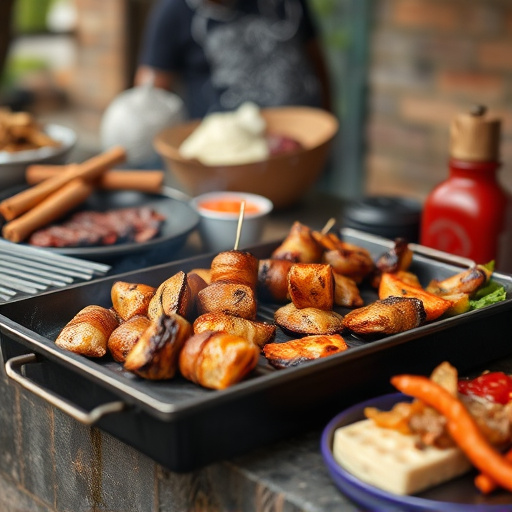For an irresistible pulled pork BBQ recipe, choose high-quality shoulder or butt cuts for their rich marbling and large surface area ideal for slow cooking. Season with a dry rub or marinate overnight to unlock the meat's full flavor potential, resulting in a tender, juicy dish that satisfies any barbecue lover.
“Unleash the mouthwatering aroma of slow-cooked perfection with our comprehensive guide to crafting the ultimate pulled pork BBQ recipe. Discover the secrets behind achieving tender, flavorful meat that melts in your mouth. From choosing the right cut—opt for the juicy shoulder or butt meat—to mastering seasonings and marinades, we’ll walk you through every step. Learn the art of slow cooking, from setting up your slow cooker to serving suggestions, and create a pulled pork dish that’s sure to become a family favorite.”
- Choosing the Right Cut of Meat for Pulled Pork
- – Understanding the ideal cut for slow cooking
- – Benefits of using shoulder or butt meat
- Seasoning and Marinades for Maximum Flavor
Choosing the Right Cut of Meat for Pulled Pork

When it comes to making flavorful pulled pork, selecting the right cut of meat is a crucial first step in your BBQ journey. Opt for a good quality, well-marbled shoulder or butt cut—these are the workhorses of pulled pork recipes. The fat content ensures the meat stays moist and tender during slow cooking, resulting in a mouthwatering dish that’s perfect for any barbecue.
In a pulled pork BBQ recipe, you want a cut that can be slowly cooked to break down its connective tissues, making it shreddable and incredibly juicy. Both the shoulder and butt cuts have their advantages; the shoulder offers more flavor potential due to its rich marbling, while the butt provides a larger surface area for slow-cooking, ensuring every piece of meat is melt-in-your-mouth delicious.
– Understanding the ideal cut for slow cooking

When it comes to slow-cooking the perfect pulled pork BBQ, choosing the right cut is key. The ideal choice for this method is a lean cut of pork with plenty of fat marbled in – this ensures both tender, flavorful meat and juicy results. Look for cuts like shoulder or butt (also known as brisket), which are not only affordable but also rich in collagen, transforming into delicious, succulent meat when cooked low and slow.
These cuts have a higher fat content, which helps to keep the pork moist during the long cooking process, resulting in those signature tender, shredded pieces that make pulled pork so delectable. So, for an authentic, flavorful pulled pork BBQ recipe, start with a high-quality cut of pork designed for slow cooking – you won’t be disappointed!
– Benefits of using shoulder or butt meat

Using shoulder or butt meat for your pulled pork BBQ recipe offers several advantages that contribute to a truly flavorful and tender result. This cut of meat is known for its rich, hearty taste and exceptional marbling, which ensures a moist and juicy final product. The slow cooking process used in overnight preparation breaks down the tough connective tissues present in these cuts, transforming them into shreds of succulent meat.
Moreover, shoulder or butt meat is often more affordable than other parts, making it an economical choice for pulled pork. Its larger size allows for a longer, slower cook time, enhancing the development of those deep, savory flavors that characterize a perfect pulled pork BBQ recipe. This method also helps to maintain the integrity of the meat, resulting in a final dish that is both aromatic and deliciously tender.
Seasoning and Marinades for Maximum Flavor

Seasoning and marinades play a crucial role in enhancing the flavor of your pulled pork BBQ recipe. The right blend of spices can transform simple pork into a mouthwatering dish. Start by rubbing the meat with a dry rub consisting of salt, pepper, paprika, garlic powder, and onion powder. This initial seasoning not only flavors the pork but also helps to break down the muscle fibers, making it tenderer.
For maximum impact, consider marinating the pulled pork overnight. A good marinade should include a base of oil or vinegar to help penetrate the meat, along with acid (like lemon juice or yogurt), aromatics (such as garlic and onions), and various spices. The acidity helps to soften the pork while the spices add depth and complexity to the final flavor profile. You can experiment with different combinations like brown sugar and chili powder for a sweet and spicy twist, or go for a classic approach with mustard and black peppercorns.
